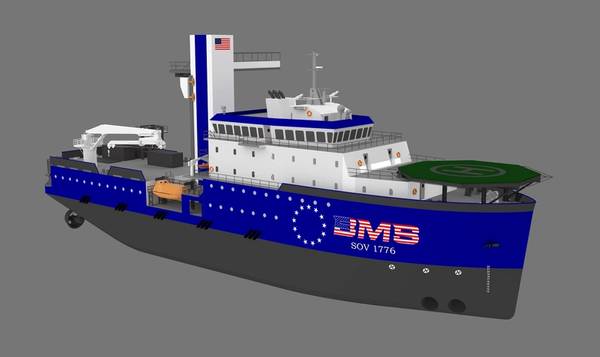
Covington, La. based marine engineering firm Baker Marine Solutions has unveiled a new service operation vessel (SOV) design for the U.S. offshore wind industry.
The new 275-foot (LOA) BMS 1776 is designed be built in the U.S. to ABS class standards and is fully certified to operate in U.S. waters, utilizing U.S. offshore workers, BMS said.
"With the U.S. offshore wind industry expanding rapidly, U.S. companies must be ready to build SOVs designed specifically for U.S. shipyards to support the installation and maintenance of domestic wind farms," said BMS president Jim Baker. "The BMS 1776 brings this capability back home."
The construction design eliminates the need for advanced fabrication techniques such as hot and cold steel rolling, reducing overall construction costs and the total build time, according to the designer. The SOV will have a breadth of 57 feet and 19-foot draft.
The BMS 1776 has been created with the goal to to reduce carbon emissions in the design, construction, operation and maintenance of the vessel, BMS said. For example, hull optimization studies from MARIN increased hull efficiency by 23%, resulting in a top speed of 13.5 knots.
The vessel is spec’d with a state-of-the-art BlueDrive PlusC system from Siemens that will increase safety, cut operational costs, improve lifecycle economics and decrease the total carbon footprint. Variable-speed generators will allow engines to run at optimal speed set points based on most-efficient fuel consumption and torque capability.
In addition, an available hybrid battery system can store excess energy and enable peak shaving when required. The battery system further increases redundancy and improves dynamic operation of the engines, while lowering total running hours. Electric regenerative actuation allows the vessel's walk-to-work gangway system to decrease energy use by more than 80% when compared to hydraulic power pack-driven models.
A “digital twin” of the vessel is kept using existing production models, allowing monitoring of the lifecycle for every part on board. This results in easy maintenance scheduling while minimizing downtime. Direct emissions monitoring allows operators to track emissions onboard and remotely in real time.
Length overall: 275 ft
Breadth: 57 ft
Draft: 19ft
Depth: 26ft
Deadweight: 3,000LT
Speed: 13.5 knots
Endurance 30 days without port call
Capacities
Potable Water: 236,000 gal
Water Ballast: 530,000 gal
Fuel Oil: 290,000 gal
Wastewater: 9,000 gal
Main Diesel Generators: 4 x 1900 kW each
Propulsion: 2 x L-Drives 2000kW
Bow Thrusters: 2 x Tunnel Thruster 900kW, 1 x Retractable Thruster 700kW
Dynamic Positioning: DPS-2
Life Saving Equipment
Lifeboats: 2 x 37 Person
Rescue Boat: 2 x Fast C or B
Gangway: W-Type Ampelmann motion compensating with 2t cargo lifting capability
Deck Crane: SWL 5T/15T with 29m/18m maximum weach
Cargo Loading Platform: Hydraulic deck hatch and RoRo ramp for fast loading of standardized cargo
Warehouse: 4,795 ft2 climate controlled
Open Deck: 5,000 ft2
Helideck: 50 ft
Accommodation
POB: 60
Cabins: 56 Single, 4 Suites
Facilities
Hospital, Cinema, Lounge, Gymnasium
2 Laundry Rooms
2 Conference Rooms
8 Offices
Classification: ABS A1 (Wind IMR), AMS, ACCU, HAB (WB), E, GREEN PASSPORT, ENVIRO, UWILD, DPS-2